Cite this document
(“The Regulation of Cyberspace Activity Essay Example | Topics and Well Written Essays - 4000 words”, n.d.)
Retrieved from https://studentshare.org/technology/1538167-the-regulation-of-cyberspace-activity
Retrieved from https://studentshare.org/technology/1538167-the-regulation-of-cyberspace-activity
(The Regulation of Cyberspace Activity Essay Example | Topics and Well Written Essays - 4000 Words)
https://studentshare.org/technology/1538167-the-regulation-of-cyberspace-activity.
https://studentshare.org/technology/1538167-the-regulation-of-cyberspace-activity.
“The Regulation of Cyberspace Activity Essay Example | Topics and Well Written Essays - 4000 Words”, n.d. https://studentshare.org/technology/1538167-the-regulation-of-cyberspace-activity.


